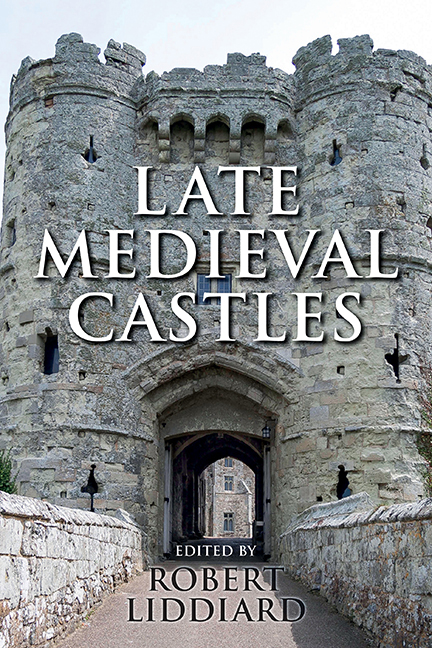Book contents
- Frontmatter
- Contents
- List of Illustrations
- Acknowledgements
- Editor's Preface
- List of Abbreviations
- A Note on the Text
- Introduction
- 1 Fourteenth-Century Castles in Context: Apotheosis or Decline?
- 2 Architects, Advisors and Design at Edward I's Castles in Wales
- 3 The Courtyard and the Tower: Contexts and Symbols in the Development of Late Medieval Great Houses
- 4 Castle Planning in the Fourteenth Century
- 5 Meaningful Constructions: Spatial and Functional Analysis of Medieval Buildings
- 6 Mota, Aula et Turris: The Manor-Houses of the Anglo-Scottish Border
- 7 Lulworth Castle, Dorset
- 8 A Scottish Problem with Castles
- 9 Structural Symbolism in Medieval Castle Architecture
- 10 Specimens of Freedom to Crenellate by Licence
- 11 Some Analysis of the Castle of Bodiam, East Sussex
- 12 English Castles in the Reign Of Edward II
- 13 Castles of Ward and the Changing Pattern of Border Conflict in Ireland
- 14 The Donjon Of Knaresborough: The Castle As Theatre
- 15 The Architecture of Arthurian Enthusiasm: Castle Symbolism in the Reigns of Edward I and his Successors
- 16 Medieval Ornamental Landscapes
- 17 Otherworld Castles in Middle English Arthurian Romance
- Guide to Further Reading
- Index
9 - Structural Symbolism in Medieval Castle Architecture
Published online by Cambridge University Press: 29 April 2017
- Frontmatter
- Contents
- List of Illustrations
- Acknowledgements
- Editor's Preface
- List of Abbreviations
- A Note on the Text
- Introduction
- 1 Fourteenth-Century Castles in Context: Apotheosis or Decline?
- 2 Architects, Advisors and Design at Edward I's Castles in Wales
- 3 The Courtyard and the Tower: Contexts and Symbols in the Development of Late Medieval Great Houses
- 4 Castle Planning in the Fourteenth Century
- 5 Meaningful Constructions: Spatial and Functional Analysis of Medieval Buildings
- 6 Mota, Aula et Turris: The Manor-Houses of the Anglo-Scottish Border
- 7 Lulworth Castle, Dorset
- 8 A Scottish Problem with Castles
- 9 Structural Symbolism in Medieval Castle Architecture
- 10 Specimens of Freedom to Crenellate by Licence
- 11 Some Analysis of the Castle of Bodiam, East Sussex
- 12 English Castles in the Reign Of Edward II
- 13 Castles of Ward and the Changing Pattern of Border Conflict in Ireland
- 14 The Donjon Of Knaresborough: The Castle As Theatre
- 15 The Architecture of Arthurian Enthusiasm: Castle Symbolism in the Reigns of Edward I and his Successors
- 16 Medieval Ornamental Landscapes
- 17 Otherworld Castles in Middle English Arthurian Romance
- Guide to Further Reading
- Index
Summary
This article is offered in the hope of assisting a juster understanding of so-called licences to crenellate as a source for the archaeologist and the architectural historian. It seeks to indicate their proper context and to relate them to their counterparts in medieval France. The social significance of seignorial authorisation to fortify has not hitherto received the attention it merits. The wider implications for architectural symbolism in general will, it is hoped, be of interest to scholars working in other fields.
The medieval fortress of the castle age proper, namely the period from the twelfth to the later fifteenth century, when masonry structures were the dominant element in the fortification of Western Europe, was, in its way, as intentionally evocative and symbolic as any late eighteenth- and nineteenth-century castellated mansion of the Romantic Revival. Accommodation that was sometimes truly palatial but always in some degree noble was the everyday purpose. Although needing also to be in very varying measure defensible, according to local and personal circumstances, the social purposes of fortresses almost always comprehended and transcended their military functions. Castles were seldom, if ever, in their own day purely functional fortifications; certainly, they were often homes as well (which fact imported an extra set of governing criteria), but, above all else, their builder sought to evoke in some manner the moeurs of chivalry, the lifestyle of the great, and the legends of the past.
A few castles only were siege-worthy but most were capable of deterring, though not for a prolonged period of actually resisting, something less than well-equipped and organised attack; whereas common to all of them, of whatever nature their structure, was this sentiment of nostalgia. It may well be that, in this respect, the castellated architecture of the Middle Ages has closer affinities than might be supposed with so much building of the Tudor and early Stuart period in England and also, but more remotely, with that of the modern Romantic Revival in Western Europe. The symbolism of castle architecture might, in rare cases, be not much more than an accident of true functional efficiency, domestic and military, but even so it was never a purely utilitarian architecture.
- Type
- Chapter
- Information
- Late Medieval Castles , pp. 199 - 220Publisher: Boydell & BrewerPrint publication year: 2016



